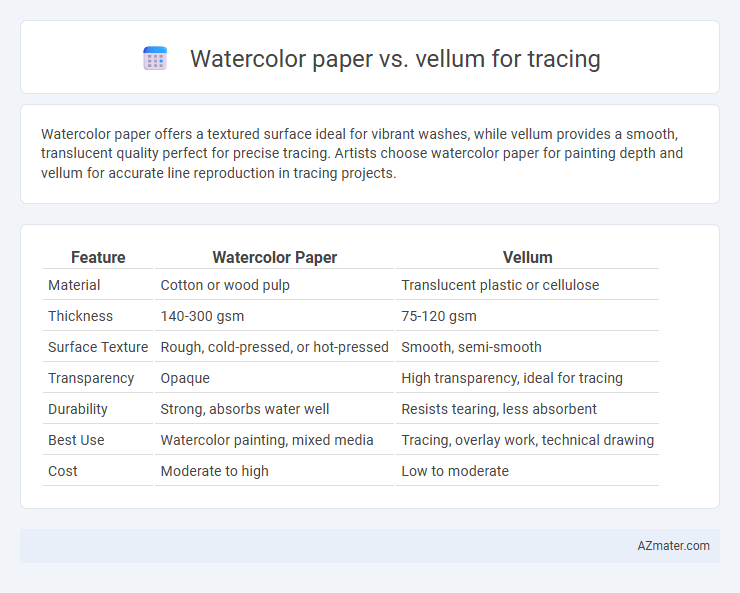Watercolor paper offers a textured surface ideal for vibrant washes, while vellum provides a smooth, translucent quality perfect for precise tracing. Artists choose watercolor paper for painting depth and vellum for accurate line reproduction in tracing projects.
Table of Comparison
| Feature | Watercolor Paper | Vellum |
|---|---|---|
| Material | Cotton or wood pulp | Translucent plastic or cellulose |
| Thickness | 140-300 gsm | 75-120 gsm |
| Surface Texture | Rough, cold-pressed, or hot-pressed | Smooth, semi-smooth |
| Transparency | Opaque | High transparency, ideal for tracing |
| Durability | Strong, absorbs water well | Resists tearing, less absorbent |
| Best Use | Watercolor painting, mixed media | Tracing, overlay work, technical drawing |
| Cost | Moderate to high | Low to moderate |
Introduction: Understanding Watercolor Paper and Vellum
Watercolor paper is specifically designed to absorb water and pigment, featuring a textured surface that helps create rich, vibrant paintings. Vellum, a smooth, translucent material traditionally made from animal skin but now often synthetic, is prized for its durability and clarity in tracing detailed drawings. Understanding these fundamental differences aids artists in selecting the right medium for tracing, ensuring optimal performance and artistic results.
Material Composition: What Sets Them Apart?
Watercolor paper is typically made from 100% cotton or a blend of cotton and wood pulp, offering a textured surface that absorbs water and pigment effectively, making it ideal for painting. Vellum, traditionally crafted from animal skin or synthetic materials like polyester, features a smooth, translucent surface specifically designed for detailed tracing work. The primary distinction lies in watercolor paper's absorbency and texture compared to vellum's smoothness and translucency, which directly impacts their suitability for art and tracing tasks.
Texture and Surface Quality Comparison
Watercolor paper offers a textured surface with natural tooth that enhances pigment absorption and creates dynamic effects, while vellum features a smooth, translucent surface ideal for precise tracing and fine detail work. The rough texture of watercolor paper can distort underlying images, making it less suitable for accurate tracing, whereas vellum's smoothness allows for clearer visibility and cleaner lines. Artists selecting materials for tracing should consider the balance between texture-induced artistic effects and the need for surface clarity and detail fidelity.
Transparency and Tracing Performance
Watercolor paper offers limited transparency due to its textured, fibrous surface, which may hinder precise tracing accuracy. Vellum is highly transparent and smooth, allowing for superior tracing performance with clear visibility of underlying lines. Artists seeking precision tracing typically prefer vellum for its consistent transparency and ease of use.
Durability and Handling
Watercolor paper offers superior durability and a textured surface ideal for handling during tracing, resisting warping and tearing under repeated erasures. Vellum, with its smooth and translucent surface, provides excellent light transmission for precise tracing but is more prone to smudging and less resistant to wear and moisture. Artists prioritizing longevity and robust handling typically prefer watercolor paper, while those seeking clarity and fine detail in tracing may opt for vellum despite its fragility.
Compatibility with Various Mediums
Watercolor paper offers superior compatibility with wet mediums like watercolors and inks due to its absorbent texture, preventing warping and allowing vibrant color application. Vellum's smooth, semi-translucent surface excels in precision tracing but is less receptive to heavy wet media, often causing smudging or warping when it comes to water-based paints. For mixed media projects requiring both tracing and layering with watercolors, combining vellum for initial outlines and watercolor paper for final painting ensures optimal medium performance and detail retention.
Cost and Availability
Watercolor paper generally costs more than vellum due to its specialized texture and weight designed for water absorption and artistic durability. Vellum, often used for tracing because of its smooth surface and translucency, is typically more affordable and widely available in art supply stores and online. The cost-effectiveness and easier access of vellum make it a preferred choice for artists focused on tracing without the need for watercolor-specific qualities.
Best Uses for Watercolor Paper in Tracing
Watercolor paper offers a textured surface that holds graphite and ink well, making it ideal for tracing intricate designs that require durability and detailed work. Its heavyweight nature prevents bleeding and warping, ensuring clean lines when layering watercolor washes over traced images. Artists prefer watercolor paper for tracing complex compositions that will be further developed with paint, as it maintains integrity throughout various media applications.
When to Choose Vellum for Tracing Projects
Vellum is ideal for tracing projects requiring precise line visibility and smooth surface texture, as its semi-translucent quality allows for clear overlay and easy reproduction of intricate details. Compared to watercolor paper, vellum offers less texture, making it preferable when accuracy and fine line work are critical, especially in architectural or technical drawings. Artists and designers should choose vellum for tracing when they need a smooth, stable medium that minimizes distortion and facilitates clean, crisp tracing results.
Final Verdict: Which Is Better for Your Needs?
Watercolor paper offers a textured surface ideal for watercolor techniques but can be less transparent for tracing compared to vellum, which provides exceptional clarity and smoothness for precise line work. Vellum is generally preferred by artists who require sharp, clean tracings due to its translucency, while watercolor paper suits those integrating tracing with painting directly on the paper. Choosing between watercolor paper and vellum depends on whether the primary focus is tracing accuracy or blending tracing with watercolor application.

Infographic: Watercolor paper vs Vellum for Tracing
 azmater.com
azmater.com